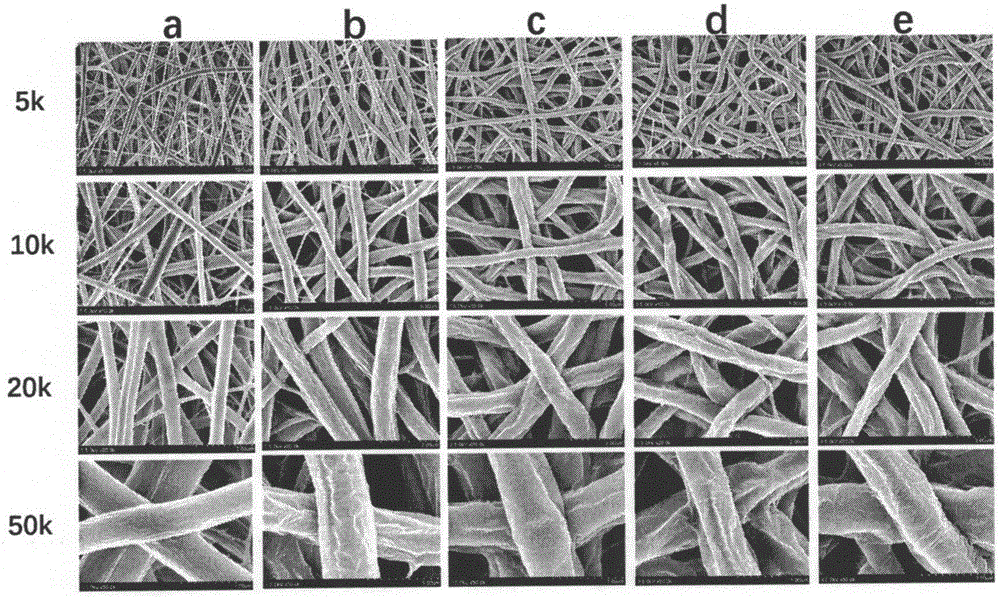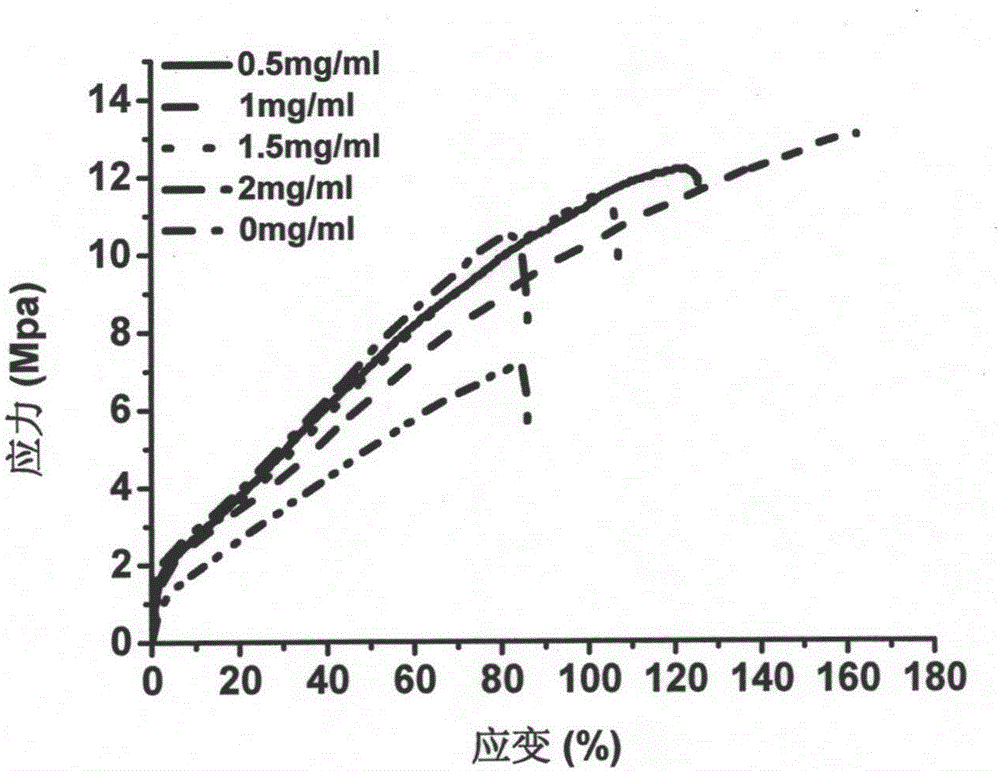Method for preparing composite nanofiber tissue engineering scaffold based on graphene oxide
A technology of tissue engineering scaffolds and composite nanofibers, applied in fiber treatment, animal fibers, non-woven fabrics, etc., to achieve the effect of promoting adhesion, good biocompatibility, and simple operation
- Summary
- Abstract
- Description
- Claims
- Application Information
AI Technical Summary
Problems solved by technology
Method used
Image
Examples
Embodiment 1
[0044] A preparation method based on graphene oxide composite nanofiber tissue engineering scaffold, the specific steps are:
[0045] 1. Put the tussah silk in the environment of 95~100℃, 2 CO 3 The degumming solution was degummed 3 times, each time for 30 minutes, and the bath ratio was 1:50. After degumming, the tussah silk fibers are obtained and dried at 60°C. Put the tussah silk fibroin fiber in a saturated LiSCN solution at a bath ratio of 1:10, dissolve it for 70 minutes at 50°C±2°C, put the obtained tussah silk fibroin protein solution into a dialysis bag with a molecular weight cut-off of 8-10KDa, and use Dialyzed with deionized water for 3 days, and freeze-dried to obtain tussah silk fibroin.
[0046] 2. Weigh 0.125g of silk fibroin and 0.375g of high molecular polymer, dissolve them in 5ml of hexafluoroisopropanol, and magnetically stir at a certain rate until completely dissolved to obtain a spinning fiber with a concentration of 10% (w / v). liquid. Perform ele...
Embodiment 2
[0049] A preparation method based on graphene oxide composite nanofiber tissue engineering scaffold, the specific steps are:
[0050] 1. Place the tussah silk at 95~100℃ 2 CO 3 The degumming solution was degummed 3 times, each time for 30 minutes, and the bath ratio was 1:50. After degumming, the tussah silk fibers are obtained and dried at 60°C. Put the tussah silk fibroin fiber in a saturated LiSCN solution at a bath ratio of 1:10, dissolve it for 70 minutes at 50°C±2°C, put the obtained tussah silk fibroin protein solution into a dialysis bag with a molecular weight cut-off of 8-10KDa, and use Dialyzed with deionized water for 3 days, and freeze-dried to obtain tussah silk fibroin.
[0051] 2. Weigh 0.125g of silk fibroin and 0.375g of high molecular polymer, dissolve them in 5ml of hexafluoroisopropanol, and magnetically stir at a certain rate until completely dissolved to obtain a spinning fiber with a concentration of 10% (w / v). liquid. Perform electrospinning and w...
Embodiment 3
[0054] A preparation method based on graphene oxide composite nanofiber tissue engineering scaffold, the specific steps are:
[0055] 1. Put the tussah silk in the environment of 95~100℃, 2 CO 3 The degumming solution was degummed 3 times, each time for 30 minutes, and the bath ratio was 1:50. After degumming, the tussah silk fibers are obtained and dried at 60°C. Put the tussah silk fibroin fiber in a saturated LiSCN solution at a bath ratio of 1:10, dissolve it for 70 minutes at 50°C±2°C, put the obtained tussah silk fibroin protein solution into a dialysis bag with a molecular weight cut-off of 8-10KDa, and use Dialyzed with deionized water for 3 days, and freeze-dried to obtain tussah silk fibroin.
[0056] 2. Weigh 0.125g of silk fibroin and 0.375g of high molecular polymer, dissolve them in 5ml of hexafluoroisopropanol, and magnetically stir at a certain rate until completely dissolved to obtain a spinning fiber with a concentration of 10% (w / v). liquid. Perform ele...
PUM
| Property | Measurement | Unit |
|---|---|---|
| Concentration | aaaaa | aaaaa |
Abstract
Description
Claims
Application Information
 Login to View More
Login to View More - R&D
- Intellectual Property
- Life Sciences
- Materials
- Tech Scout
- Unparalleled Data Quality
- Higher Quality Content
- 60% Fewer Hallucinations
Browse by: Latest US Patents, China's latest patents, Technical Efficacy Thesaurus, Application Domain, Technology Topic, Popular Technical Reports.
© 2025 PatSnap. All rights reserved.Legal|Privacy policy|Modern Slavery Act Transparency Statement|Sitemap|About US| Contact US: help@patsnap.com



